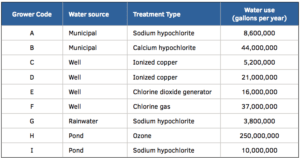
What is the Cost of Your Water?
We tend to think of irrigation water as a cheap resource. However, both the water you use and wastewater that runs off to the environment might be more valuable than you think. Irrigation water cost is generally highest if you use municipal supply in an urban area. Treating the water with a technology such as chlorine adds cost. If you use a water-soluble fertilizer, this further increases cost of the nutrient solution (water plus fertilizer).
Water conservation is an environmental stewardship activity that growers “should do,” and are sometimes forced to do by regulation. As a business, knowing the cost of your water will also help you make economically rational decisions such as the return on investment in water conservation technologies. In locations with limited available water volume, the resource is even more valuable to the survival of your business.
Cost of Irrigation Water from Commercial Greenhouses
We estimated the total cost of irrigation water from eight commercial greenhouse operations (Table 1). The total cost included the cost of water source, fertilizer and treatment of the nutrient solution. Costs were calculated per 1,000 gallons of water treated.

Cost of water source. This included the capital cost to establish wells, ponds or rainwater collection systems, the purchase price of pumps and operational costs. Capital costs were linearly depreciated for 40 years for the establishment of the system and 20 years for water pumps. The capital cost per 1,000 gallons equaled the upfront investment for the business, divided by depreciation years, and then divided by the annual water volume used. Operational costs represented the electricity cost of pumping water or the purchase price of municipal water.
Cost of fertilizers. Six of the eight growers provided the actual cost they paid for fertilizers. A fertilizer supply company provided prices for the two growers not reporting fertilizer cost, based on 100-ppm nitrogen using 17-4-17. All surveyed growers used water-soluble fertilizers as their main nutrient supply.
Cost of treatment. Water quality can differ in terms of chemical (dissolved ions and agrichemicals), biological (microbes and pathogens) and physical (suspended particle) contaminants. Therefore, the cost to treat water to a horticulturally-acceptable level depends on the water source (Figure 1). Municipal supply water tends to have high biological and physical quality (few microbes or particles, respectively), but sometimes needs treatment to correct chemical problems such as high EC or alkalinity.
Similarly, chemical water quality issues are the most likely issue for water from deep wells. Rainwater is originally very pure, but during storage microbes can grow in ponds or holding tanks, requiring sanitation and subsequent filtration. Pond water typically has a high concentration of microbes that may include algae and plant pathogens, requiring sanitation and filtration and pH may be high. Recirculated irrigation water often has a high concentration of particles, plant pathogens may be present and the EC level may be high from fertilizer and other ions. These are general trends for water sources, and testing water quality is necessary to evaluate the need for treatment at your location. For more information on the cost of sanitation, see last month’s article in this series.
Results From Our Survey
Water source (Figure 2, blue bar). The cost at the two locations using municipal water was $3.94 or $6.43 per 1,000 gallons, respectively. Rainwater was highly priced because of the high capital cost ($380,121) to collect and then hold water in 500,000-gallon metal tanks. Well and pond water sources were inexpensive compared with municipal and rainwater sources. The cost of well water ($0.09 to $0.64/1,000 gallons) differed between operations depending on the number of
wells per location required to supply sufficient water (increasing cost with increasing well number). Differences in pond water cost ($0.02 to $0.25/1,000 gallons) depended mainly on the water volume pumped from each pond (decreasing cost with increased volume).

Cost of water-soluble fertilizers (Figure 2, green bar). The cost of water-soluble fertilizers in the nutrient solution ($0.90 to $6.91/1,000 gallons) was the most expensive component of the total nutrient solution cost, except in the location with the highest-priced municipal water.
Water treatment (Figure 2, yellow bar). In most cases, water treatment ($0.68 or less/1,000 gallons) contributed the lowest portion of the nutrient solution cost. In most locations, the cost of water treatment at that location was lower than the cost of the water source. Consequently, when the water source is expensive, it is especially cost-effective to capture, treat and reuse.
Conclusion
The cost of water source, treatment technology and fertilization varied widely by operation, water volume and geographic location. Therefore, estimate your own costs and potential benefits before investing in new technologies.
Fertilizer is a valuable resource. When it comes to irrigation, fertilizer represents a high portion of the cost of a nutrient solution. Economic savings in the cost of water-soluble fertilizers may be enough to justify recirculating irrigation water. In other words, capture and reuse of runoff fertilizer turns a waste that causes eutrophication into a resource that lowers the cost of fertilizing other crops.
Cost and risk can be reduced by prioritizing high quality/expensive water sources for sensitive crops such as young plants and orchids, and lower quality/low cost sources for crops such as nursery container stock that can tolerate a range in water quality.
Managing risk is another aspect of your overall water supply strategy. Using lower-quality (and often low-cost) water sources such as recirculated irrigation water also comes with increased treatment cost to avoid risks such as water-borne pathogens. Having multiple water sources reduces the risk of drought years and water restrictions. Overall, considering the cost of water makes good business sense.
Acknowledgements. Thanks to funding support and collaborator from industry partners the Floriculture Research Alliance.


 Video Library
Video Library 




















